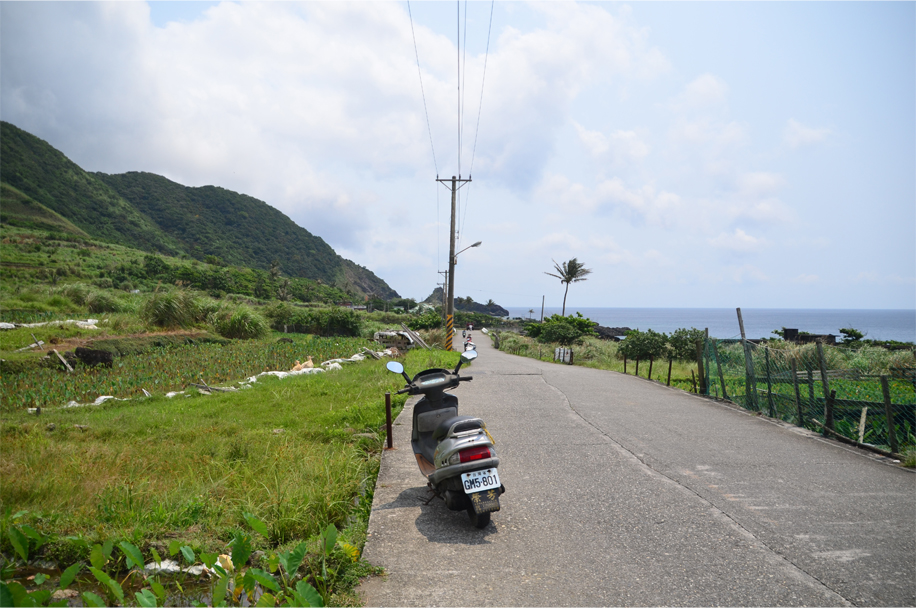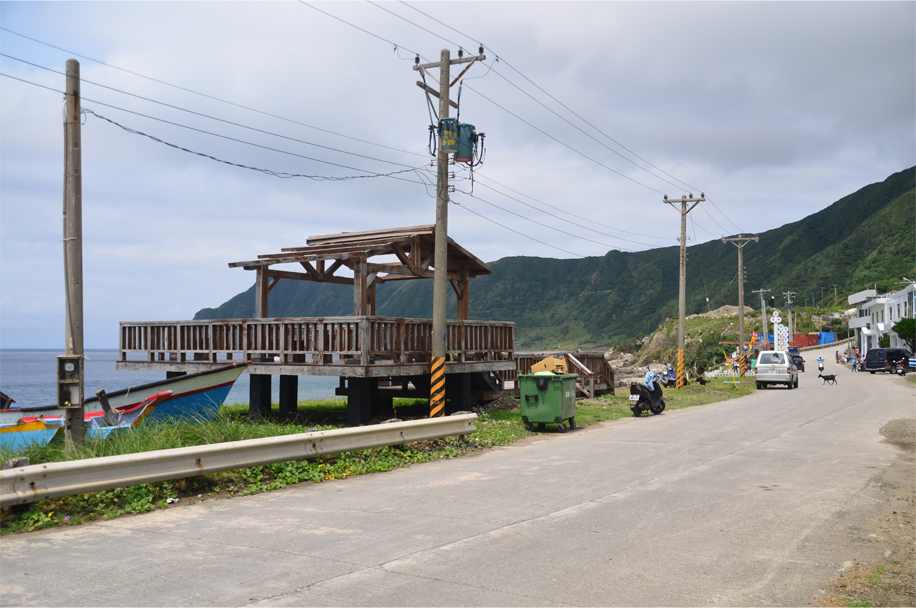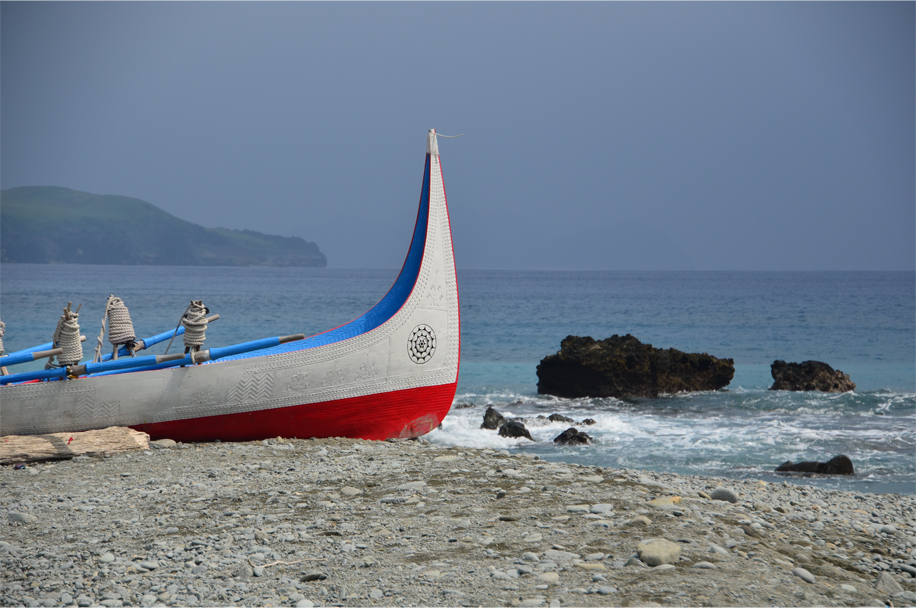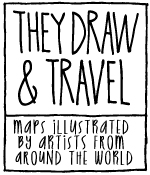Syaman’s exchange

“So you want to buy a canoe?” The shopkeeper smiled and looked at us thoughtfully. “Wait a moment; I think I know just the place.”
Bama and I had parked our scooter at the edge of Langdao village, heading indoors to take shelter from the howling winds that were buffeting the north shore of the island. Shaokang, the young proprietor of our homestay, had pointed us to this handicrafts centre and workshop. “It’s good for souvenirs… if you’re looking for something traditional made by the locals.” By the end of that first day, we knew that we both wanted a miniature canoe as a memento of Orchid Island.
Soon the shopkeeper returned with a ballpoint pen and a blank sheet of paper. We leaned closer as a series of lines and boxes gradually took shape – first the main harbour at Kaiyuan, where the ferries docked, then the gas station and supermarket. Further down the page he labelled the police station and a nearby restaurant, all threaded together by the main road circling the island.
“You can’t miss it. It’s a small shop right by the police station, at the bend in the road in Yeyou village. There’s a store just opposite run by the same man.”
The map pointed to the workshop of Syaman Jiavitong, a name that would only become familiar once the transaction had taken place.
We first showed up at two in the afternoon, finding a darkened white shack with several rows of miniature canoes in various states of completion, just visible through the reflective window. Outside, a well-worn work table was peeling in the humid ocean air, its plywood top bending and fraying at the edges.
Suddenly a voice spoke out from behind my left shoulder. “What would you like?” I turned around, seeing the sage-like face of Syaman Jiavitong but not yet realising who he really was. “We’d like to buy some small boats,” I replied. He pushed open the door, flicked on the light and gestured us in.
The canoes were astonishing. Each vessel was carefully handcarved from a single block of wood, and vividly painted in the traditional colours of the Tao. A layer of virgin white was overlaid with triangles of black, mediated by sweeping curves of deep red and motifs that spoke of the Tao’s venerence of the sea. Inside the canoe, the exposed wood was coated in a varnish that gave the material a rich, dark tone suggestive of tropical hardwood.
By now another visitor had followed us in, and I overheard Syaman explaining that they each took a month to finish. “How much does one cost?” we asked.
“It’s 3,500 [Taiwanese dollars] for these ones, and 4,000 for the larger boats.” I baulked at the price, knowing full well that it was the equivalent of two nights’ accommodation for both of us at the homestay. The woman behind us was equally surprised, and she quickly left the shop after a polite ayoy. Not wanting to come away empty-handed, we lingered by the door where a series of trinkets had been hung. Eventually I bought a decorative strap made with beads as a small consolation. Syaman was thankful, and as we bid him meikunan he flashed us a bright smile and wished us the same.
Disappointed, I pondered the value of 3,500 Taiwan dollars as we tore down the west coast on our scooter, passing the empty airport runway in strong gusts and a light drizzle. That amounted to roughly 900 Hong Kong dollars or just under US$120 – a sum I was reluctant to part with on any normal occasion. But such was the quality of its craftsmanship under Syaman’s hands that I felt increasingly compelled to buy a miniature canoe. What better way to give back, I thought, than to support a local artisan?
Against my better judgement, we returned less than two hours later in the hope that Syaman had not left his post. But he was gone. The convenience store that he ran with his wife just across the street was dark too, and after another fifteen minutes of waiting I gave up and we returned to our homestay at Hongtou village.
Shanti was there in the living room, where I sank into the peach-coloured sofa and relayed the day’s events. She knew exactly who Syaman was.
“He’s one of the few sculptors left who can still carve like this. On this island, he’s zùi lì hài – the best of them all.” Shanti’s eyes lit up and her expression grew animated. “He even goes out and chops the wood himself! Many times I’ve passed by when he’s hard at work outside the shop, and that scent of freshly cut wood… mmm, how sweet it is!”
I smiled, trying to picture the scene from her descriptions. “And the shop – it isn’t open in the afternoon? We tried going there just now but no one was in.”
“You’ll have better luck returning at nightfall.”
Shanti was right. At 6:15 the lights at both the workshop and convenience store were blazing like beacons in the darkness. Syaman’s wife, a broad-shouldered woman with a veritable afro and the air of a headmistress, was at the counter beneath a plain, wall-mounted clock. The sculptor himself was midway through his dinner, sat at a folding table with his back turned towards the street. “Excuse me, we’d like to buy some sculptures,” I politely said to his wife. She scowled. “Can’t you see he’s having his dinner? We also need our time to rest. Come back at 6:30 or 7:00!”
Inwardly I wanted to tell her firmly that it was our second – no, third time to the sculpture studio that day and we had purposefully driven through the wind and rain from Hongtou village. But had I not escaped the hard-nosed impatience of Hong Kong to wind down in the languid, unhurried pace of Orchid Island? “You need to learn to relax and let things go,” Bama had told me, “that will help you on your future trips.” So I suppressed my bubbling frustration and gave the shopkeeper a nod. “Right, we’ll return at 6:30.”
We trooped out and sat down on a raised concrete foundation, watching the passing motorists and feeling the little pinpricks of drizzle on our faces. I glanced occasionally at my watch for the time. 10 minutes. 15 minutes. 20. Just as I was about to get up and return to the store, Bama grabbed my arm. “Look!” Syaman had now emerged into the rain and jacked open the door to his workshop, a sudden shaft of light spilling out onto the rain-soaked street.
“3,500, is that right?” Syaman nodded and I made my pick. Lifting it out from the rack, I gingerly set the canoe down on a low table by the door, presided over by a small lamp for detailed work. Around its base wood chippings lay like forgotten crumbs on the worn green surface. I imagined Syaman hunched over this table late at night, carefully shaping the vessel’s grooves with deft cuts of his chisel. He was a man of few words and a brooding intensity, but for a brief moment he fixed his gaze on his creation, repeating Shanti’s words. “Very few people still know how to do this.”
Syaman slowly set to work, folding and crumpling wads of newspaper while preparing a box for the miniature canoe. I pointed to a prominent sunburst pattern, one at each end of the vessel. “Does this represent the sun?”
“Those are the boat’s eyes,” Syaman replied.
“And these lines in the middle?”
“The waves of the sea.”
I watched intently as he carefully placed the canoe inside the unfolded cardboard container. When it was all packed, Syaman passed the box to me like a gift, with both hands in great deliberation. I surrendered 3,500 Taiwanese dollars, but in exchange he had given me the product of an entire month’s labour.
Syaman counted the banknotes and looked me straight in the eye. “I’ll have to go back for some change.” We followed him back across the street to the convenience store, and this time, he stood out on the pavement to thank me. I climbed on the back seat of the scooter, holding the cardboard box tightly to my torso as Bama revved up the engine. Our headlights carved a path in the darkening sheet of rain. Syaman waved us a final farewell as we sped off, a serene smile now fixed below his short-cropped moustache.
Back at the homestay I found a brochure by the bedside, revealing the work of 16 indigenous artists and their statement of intent. Syaman Jiavitong was one of them, his wistful face peering out of the page with a faraway look, as though he foresaw a bleak future for his vanishing trade.
Reading the text, I learned that Syaman dedicated much of his time at the local school, passing his craft onto the next generation. “Tell the children of Orchid Island, it doesn’t matter how hard life is, Tao culture is at the very root of our being. We must place this beautiful culture in our hearts. Only then,” it wrote, “will life’s direction feel secure.”

























I am so glad you persisted and bought the boat. I recently bought a knife that I didn’t need from a Sardinian craftsman who proudly told me how he hand makes his knives and the work that goes into each one. We need to value the skills of these people.
You’re right Debra; in this day and age those sorts of skills seem to be increasingly pushed to the sidelines. At one point I debated in my head whether I really needed the boat, how it would fit in my small suitcase, if I even had the space to display it at home… but I found the sculpture so compelling and beautiful I knew I just had to buy it.
Great shots =) Thanks for sharing
My pleasure, Ana.
An beautiful story as well:)
Thank you Sofie, I appreciate it! 🙂
James, I’m so glad you went back and bought one of Syaman Jiavitong’s miniature canoes. To own a work of skilled craftsmanship is a privilege, these days, and something that will become more rare in the future. Though, as you say, you “surrendered 3,500 Taiwanese dollars … in exchange … [for] the product of an entire month’s labour”, you’ve also helped support a person who’s working to keep his culture alive. With your happy memories of boats and the sea, this little canoe seems to be a perfect long-term reminder of a special place, a special adventure. 🙂
Looking back on it now, 3,500 Taiwanese dollars was but a small price to pay for such a beautiful work of craftsmanship; I can only imagine the number of hours Syaman spent toiling over his creation. You’re spot on Meredith, I felt a strong sense of conviction knowing that the money was going directly to a local artisan. It was perhaps the single biggest reason that prompted me to go back and make that transaction. The canoe now takes pride of place on a bookshelf, between my bed and work desk. Seeing it every day stirs up many fond memories of Orchid Island, and it always brings a sure smile. 🙂
It took an iron determination to do what we did, going back and forth from our homestay to Syaman’s small shop. Although I didn’t buy one for myself, but I really appreciate what you did to support a local artisan who’s trying to preserve his cultural heritage. I hope in the next few years there will be more people like Syaman Jiavitong on the island to safeguard local’s craftsmanship.
Bama, I’m so thankful that you were behind me on this – at times I felt guilty that I had to drag you along in the wind and rain. Perhaps the next time we go back I’ll bring a bigger suitcase and buy one of his larger canoes!
When Justin and I lived in China, we used to overpay for things all the time. Sometimes it just wasn’t worth it to haggle when I could see that the family was living in the upper room of their shop and they could obviously use the money. Justin paid top dollar once for a shoe shine on a street corner, and I never saw a shoe-shiner with such a big smile on his face! 😀
Now the canoe will remind you of Tao culture and it will be a souvenir of your trip, but it will also remind you of Syaman carving all of those boats in his workshop. 🙂
In this case I felt that it just wouldn’t be right to bargain, knowing the amount of work he put into crafting the canoe from scratch. 🙂
Your story reminds me of that time I visited Yangshuo and we haggled for about 45 minutes over the price of the river ferry. We only wanted to cross the river several times, hiking the rest of the way, and the enterprising locals were adamant that we had to pay the full price of the journey. I don’t blame them but it certainly took the shine off what I thought would be a pretty good day hike!
I really enjoyed this post. I was in a similar situation. I spent over $120 USD on a traditional ikat weaving in Indonesia. At the time, I hesitated a bit, but I couldn’t be happier now. And then a few months ago I saw a similar weaving in the US for over $300!
Lydia, I’m glad it resonated with your own experiences in Indonesia. 🙂 It was really my last chance to buy a sculpture – we were leaving the next morning and I knew that we would never find these miniature canoes on the Taiwanese mainland.
This is my favorite in the Taiwan Series James. Masterful restraint 🙂 i enjoyed both the narrative and the photos.
Thank you, James. 🙂 I wrote much of this entry the very day it happened.
You will not regret this purchase. It is a work of art.
Indeed, I think I would have been regretful had I not bought the canoe.
Enjoyed reading this very much James.. Sounds like you helped a very wise man and you are the richer for it. The boats look exquisite, would love to own a miniature too 🙂 .
Thank you, Madhu. 🙂 The miniature canoe was one of the best mementos I could ever have asked for. Not a day passes by when I don’t admire it and smile.
I love how you center this post to one story. While you and Bama cover the same area, both of you give a totally different perspective of what you’ve witnessed. I’m really sure that miniature will be one of the things that you will treasure in the future while retracing the effort you’ve done to earn it 🙂
Absolutely, Robin – the canoe has already become one of my most cherished souvenirs. On Orchid Island Bama kept telling me how much it reminded him of Samosir, and the trip he took with you there last year. Hopefully I’ll get to see Danau Toba myself sometime soon! 🙂
wow this is definitely beautiful…. I just remember the Vinta (a kind of boat) as they adorn the beautiful sea…
Yes, Orchid Island is the sort of place where you can imagine buying a small plot of land and building a guesthouse. Apologies for not replying until now… seems I missed this completely back in July!
This is such a good story, I really enjoyed reading it. There are some great shots too
Thank you Luke, I appreciate that. 🙂
From a James to another James, I really enjoy reading about your stories in Taiwan! 😉
I’ve been living here for over 2 years exploring all the best spots around the island, myself, as well. I am starting to write articles about my adventures and discoveries around Taiwan, you should check out my most recent post about the mango famrers in Tainan that saved me during CNY:
http://mytefl.net/blog/teaching-in-taiwan-farmers-saved-us/
I will be posting more about some amazing hidden locations in Taiwan soon! 🙂
Hi there James, thanks for the comment! Taiwan is a hugely underrated destination and it must be a great place to live. I’ll be looking forward to your future posts – good thing Hong Kong is just a short hop away by plane. 😉
This is the first time I have seen Pandanus fruit. it look like water coconut in Vietnam in shape but different in colors.
You should try it if you get a chance – I found the juice very tasty!
Of course, I will. By the way, in case you want to see the fruit that i mentioned, above is the picture 😛